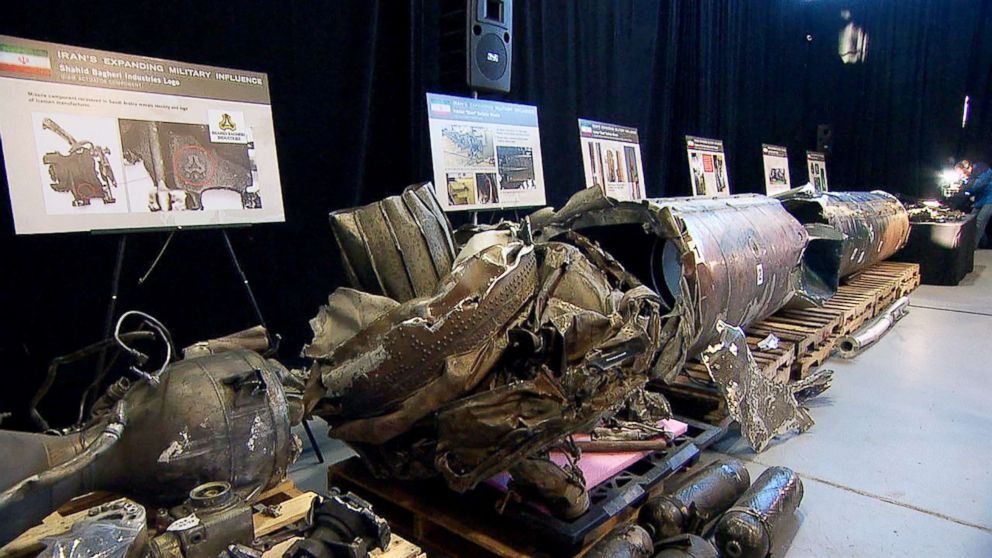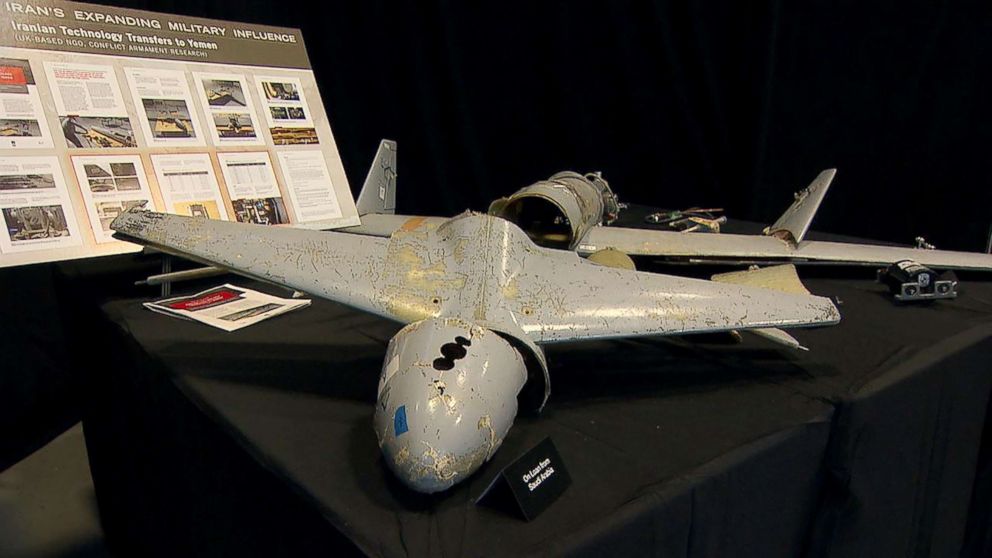Haley lays out evidence Iran violating UN Resolutions
U.S. says Iranian weapons provided to rebels in Yemen "irrefutable evidence"
— -- The Trump administration has presented Iranian missiles and weapons, allegedly sent to Houthi rebels in Yemen that it says shows Iran has violated United Nations Security Council Resolutions related to the Iranian nuclear deal.
The weapons included parts of two short-range ballistic missiles that the Pentagon says were recently fired by the Houthis into Saudi Arabia, an anti-tank guided missile, a self-guided unmanned anti-ship explosive boat and an aerial drone packed with explosives.
Nikki Haley, the U.S. Ambassador to the United Nations showed off the weapons, that she says were recovered by Saudi Arabia and the United Arab Emirates, at a warehouse at a military base in Washington D.C.
“When you see the evidence, it is absolutely indisputable,” Haley said Thursday, saying the weapons were “essentially Iranian fingerprints.”
Some of the items on display were made as early as 2005, according to the Pentagon. It is unclear when they were provided to the Houthis in Yemen and therefore whether they constitute violations of United Nations Security Council resolutions put in place in 2015.
The rollout of the weapons appears to be another step in the administration’s moves to reverse the nuclear deal with Iran.
“Today, one of the things that we’re doing with all this information is the first step of implementing President Trump’s Iran strategy, which is to expose this behavior, to be clear about it, to show it to the world and be clear eyed so we can go forward together as a community, the US and our partners in the United National in addressing the totality of the Iranian threat," said Laura Seal a Pentagon spokesperson.

In October the administration said it would not certify Iran’s compliance with the nuclear deal, a move that gave Congress 60 days to decide whether to reimpose economic sanctions on Iran, effectively killing the nuclear arms agreement.
Haley said that following the decertification the U.S. is “taking a new approach to Iran by focusing on all of the regime’s destabilizing behavior, that means we are not just focused on the nuclear program."
The weapons systems were described as having distinctive manufacturing markings and designs unique to Iranian companies and military organizations. Iran has denied allegations that it has provided weapons to Yemen's Houthi rebels.
“The evidence is undeniable,” said Haley. “The weapons might as well have had "Made in Iran" stickers all over it.”
Haley described the Iranian weapons on display as "concrete evidence" that Iran was in violation of U.N. Security Council Resolution 2231. That 2015 resolution endorsed the Iran nuclear agreement, known formally as the Joint Comprehensive Plan of Action, and calls on Iran not to undertake any activity related to ballistic missiles for eight years as well.
The weapons evidence was provided to the United Nations for its latest review of Iran's compliance with the resolution that was presented to the Security Council on Wednesday. Haley touted the report as the “strongest language yet” of Iran’s violations.

According to a copy of that report obtained by ABC News, the U.N. drew no conclusions on the weapons and is “still analyzing the information provided.”
Haley said the U.S., Saudi Arabia, the UAE were declassifying the evidence in an “unprecedented” move to show the world Iran’s “destabilizing behavior.”
Haley declined to provide specifics of what the next steps would be — saying only that the U.S. would rally support at the UN Security Council and in the international community to push back on Iran.
“We’re not done yet,” she said.
The administration has invited members of the UN Security Council and US Congress to see the evidence as well. European allies have been receptive and the US is “already getting support,” she said, as allies now “see that the president was right” about Iran.
As a backdrop, Haley was flanked by four Iranian-made weapons systems, the most prominent was a reconstructed Qiam 1 short-range ballistic missile put together from the parts of two missiles fired by Houthi rebels into Saudi Arabia in July and November, Haley said. The missile reconstruction included rocket engine parts, a booster section and the remnants of an explosive payload.
ABC News was invited on Wednesday to attend a preview hosted by the Defense Department of the Iranian weapons allegedly provided to the Houthis.
The items on display had been provided to the United States by Saudi Arabia and the United Arab Emirates, a defense official stressed "we have no reason to believe they have been altered."
Qiam 1 Missile
First used in 2014, the missile is Iran's updated version of a 1960's Soviet SCUD missile that has a longer range.
Distinctive logos on pieces of the rocket engine show they were manufactured by an Iranian company. According to the Defense Department the missile on display showed unique characteristics to the Iranian Qiam missile including the lack of stabilizer fins, replaced by a wind-bolt made by an Iranian manufacturer, and nine valves along the booster section.
The Defense Department individually numbered each valve along the booster’s side to make that point.
The displayed explosive payload came from the missile fired in November that landed close to Riyadh's international airport and consisted of metallic fragments indicating the explosive warhead had hit the ground.
Shark 33 Self-Guided Explosive Boat
On display was the guidance computer system of a "Shark 33", a self-guided unmanned explosive boat used by the Houthis in the deadly attack on the Saudi warship Madinah in January that killed two Saudi sailors.
The Shark 33's guidance system was seized by the United Arab Emirates in late 2016.
The "rudimentary" system uses desktop computer, housed in a waterproof container, and a camera to guide to guide the explosive boat towards a ship.
The Defense Department pointed out that the maritime software used by the computer is made by an Iranian-company collision avoidance and that a "fuze plate” on display matched similar plates seized at sea from an Iranian dhow loaded with hundreds of Iranian small arms intended for the Houthis.
Intriguingly the camera system was found to include pictures taken at the facility in Iran where the Shark 33’s computer was built. The photos showed a man at a desk wearing distinctive markings of the Islamic Revolutionary Guard Corps, including an IRGC hat, and as well as seven other guidance computers in the background suggesting they were all built in the same facility.
Toophan anti-tank weaponAnother displayed weapon was a Toophan anti-tank weapon that is a reverse-engineered copy of the American-made TOW anti-tank weapon. The TOW missile is optically guided by a wire to its target and can travel more than 2.3 miles (3.75 km) to its target.
According to the Defense Department a clear distinction between the two missiles is that the Iranian-made missile has a straight eject nozzle while the American nozzle has a conical shape.
The Toophan missile on display also had a date and time stamp on its structure that was consistent with the Persian calendar.
Qasef Unmanned Explosive Vehicle
The remotely piloted remotely piloted Qasef 1 drone is packed with explosives that the Defense Department said the Houthis have used in Yemen to ram into targets Kamikaze-style.
The unit on display was similar to Iran's Ababil drones and was seized by the Saudi military in Yemen.
The drone's gyroscope matched others found on Iranian-made drones and a serial number found on the unit matched similar number configurations found on other Iranian-made drones.




